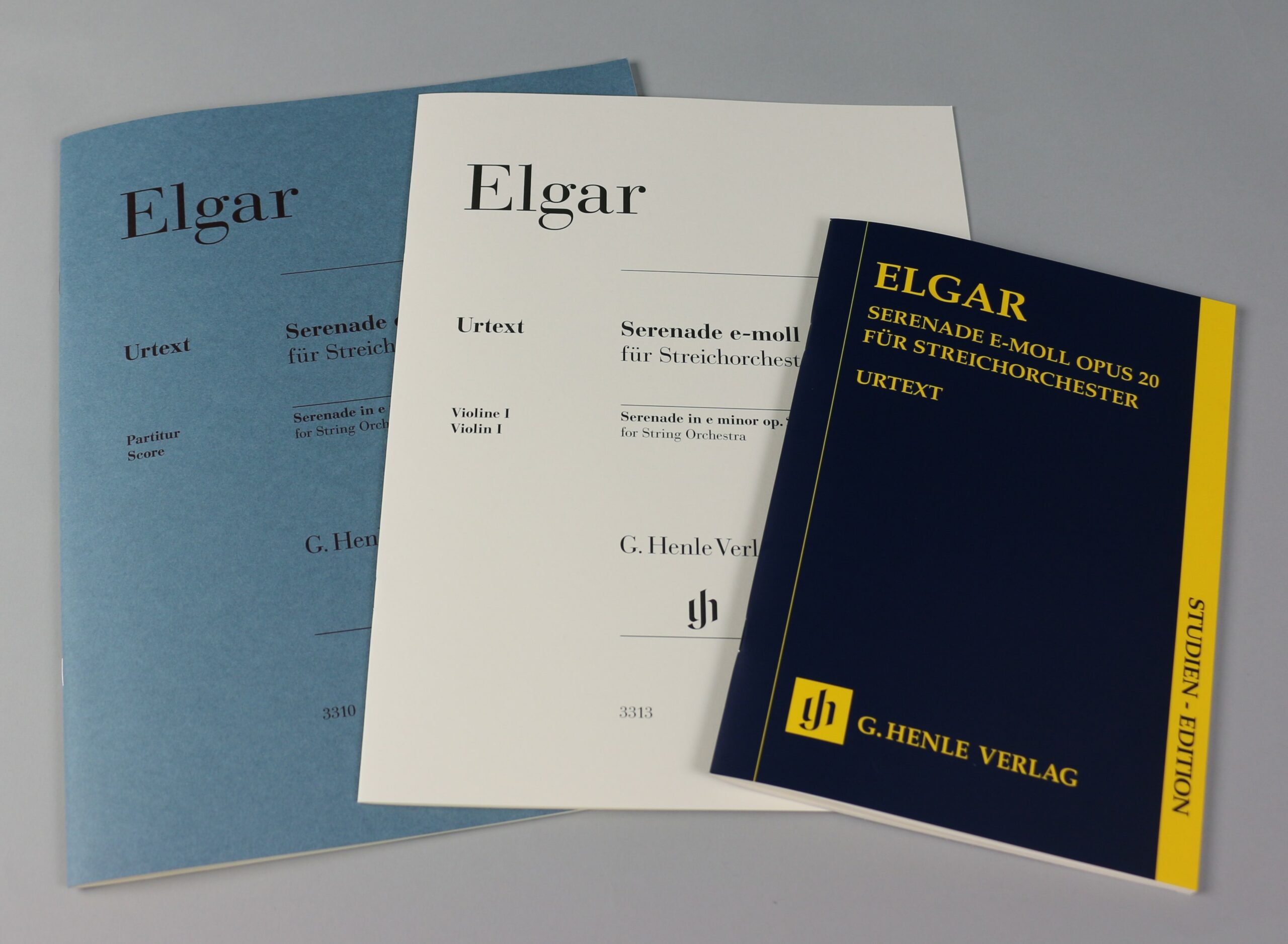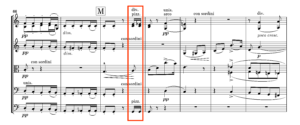 The start of 2024 is a special moment for the G. Henle publishing house, as we have just added to our catalogue a new programme segment: Music for Chamber Orchestra. In our programme we already had orchestral works and sometimes even performance material coming from various contexts, partly via our complete editions, partly pertaining to works performed as chamber and/or ‘choral’ music (such as Mozart’s ‘Kleine Nachtmusik’). But as of 2024, we are now offering complete packages, to include:
The start of 2024 is a special moment for the G. Henle publishing house, as we have just added to our catalogue a new programme segment: Music for Chamber Orchestra. In our programme we already had orchestral works and sometimes even performance material coming from various contexts, partly via our complete editions, partly pertaining to works performed as chamber and/or ‘choral’ music (such as Mozart’s ‘Kleine Nachtmusik’). But as of 2024, we are now offering complete packages, to include:
- Conductor’s full score in enlarged format
- Study edition
- Set of parts (3.3.2.2.1) in Urtext format, with all parts also available as individual exemplars
Initiating this new segment are Urtext editions of three important serenades: Dvorak’s Opus 22 (HN 3300), Tchaikovsky’s Opus 48 (HN 1550) and Elgar’s Opus 20 (HN 3310). Here below I’m interviewing Rupert Marshall-Luck, the British violinist, Elgar specialist and editor of our Elgar Serenade, regarding this edition’s special features.
Norbert Müllemann (NM): First of all, thank you very much, Rupert, for your edition of this string-orchestra classic! The Elgar Serenade is certainly one this genre’s most frequently performed pieces (Elgar’s publisher of the first edition could not yet have foreseen this: He described the serenade as a class of music that would be ‘practically unsaleable’). What significance does this wonderful work have for you personally?
Rupert Marshall-Luck (RML): I feel that there is a very ‘open-air’ quality to the Serenade – it is redolent of wind-swept hills and spring sunshine. As I myself love hillwalking, I feel a strong response to this expressive element of the work. This quality is particularly evident in the first movement, which has a wonderful sense of vitality: even in the most songful passages, eighth notes, tied across the beat, lend the line an inner energy. The second movement is richly and warmly expressive: the registration and articulation are perfectly idiomatic for string instruments, so there is a glorious sense of effortlessness, a freedom from strain. The third movement, like the first, is full of energised lyricism; but here, I think, there is something extra: a sense of yearning that we can hear in so many of Elgar’s later works – for example, in the A♭-major Symphony, or in the second movement of the Violin Concerto.
‘open-air’ quality to the Serenade – it is redolent of wind-swept hills and spring sunshine. As I myself love hillwalking, I feel a strong response to this expressive element of the work. This quality is particularly evident in the first movement, which has a wonderful sense of vitality: even in the most songful passages, eighth notes, tied across the beat, lend the line an inner energy. The second movement is richly and warmly expressive: the registration and articulation are perfectly idiomatic for string instruments, so there is a glorious sense of effortlessness, a freedom from strain. The third movement, like the first, is full of energised lyricism; but here, I think, there is something extra: a sense of yearning that we can hear in so many of Elgar’s later works – for example, in the A♭-major Symphony, or in the second movement of the Violin Concerto.
Elgar himself clearly regarded the work highly – of an early version of the work, the Three Sketches for string orchestra, he wrote ‘I like ’em (the first thing I ever did)’ – and it was one of the last pieces he recorded, on 23 July 1933. There is, however, a poignancy to his early enthusiastic response, given the subsequent rejection of the work by Novello, the firm of publishers he first approached. We know that he found professional rejection difficult to handle throughout his career, and we can easily imagine that Novello’s assessment was hard for him to bear, even though it was made on the grounds of commercial viability, rather than on (or, even, in spite of) the Serenade’s artistic merit.
NM: The sources suffice but are not ideal for an Urtext edition. Although extant are three autographs containing material from all three movements in various forms, more or less final, the fair-copy engraver’s model for the score (or the parts) has not survived. The first edition is clearly authorised by Elgar. What did this source situation imply for the edition? Can we always be sure that we are rendering the music text according to his intentions?
RML: I agree – it can actually be rather frustrating to have ‘gaps’ in the source material, especially when it seems possible that the presence of a missing source could easily resolve an issue that we otherwise need to ponder a great deal! We encountered just such a situation in this edition: extant is an autograph source for the third movement that appears to be almost complete; and in it Elgar includes some harmonics (flageolet) markings that were not preserved in the first edition. A note played as a harmonic on a string instrument has a very different sonority from a fully-stopped note, so it was most important to consider whether these markings were omitted from the first edition simply because of oversight, or whether Elgar changed his mind about them. We can’t be certain at what point this notation ‘disappeared’ (or was removed), because we have no sources that can act to ‘fill in the gap’ between the autograph and the finished, printed score. We decided, in the end, that these harmonics markings should stand in our edition – but their presence is highlighted in the Individual Comments of our Editorial Commentary, making clear to users of the edition exactly what we have done.
The other very important decision we had to make concerned the numerous discrepancies between the first-edition score and the individual parts in the markings of dynamics: the placements and durations of hairpins were especially problematic. My approach was to consider first whether it is the score or the parts that generally present a more thorough, more rigorous, notational delivery – not necessarily asserting that the reading of the source in question will always be used but serving as a useful starting-point from which to consider alternatives. In our edition, we have generally preferred the readings given in the individual parts, though there are instances where following these would result in inconsistent gradations of dynamics between the instrumental parts that cannot be justified from a musical point of view: in these cases, we have normally used instead the score’s version.
We do have another, rather interesting source for this work – the version for piano (four hands) that Elgar himself made; although this was published at about the same time as the much more familiar string-orchestra version, it has been very largely forgotten. It did, nevertheless, serve to help us make decisions regarding the placement and presence of dynamics; and it also provided useful insights into Elgar’s intentions regarding textural layering.
Overall, I think that the variety of source material we had available has enabled us to be maximally confident that we are reproducing the music text as Elgar intended it. Preparing a scholarly-critical edition can, at times, feel rather like piecing together an archaeological artifact – but it is a fascinating and very stimulating process. It will always involve a degree of interpretation – no set of sources is perfect and music notation doesn’t always explain everything; and, of course, others may sometimes reach different conclusions from the same material. That’s why the Editorial Commentary is so important – it means that decision-making in the edition is always transparent.
NM: During our collaboration on this piece, one problem has repeatedly arisen: The main source shows differing parallel passages. Or, similarly difficult: in the vertical full score, dynamics markings are not equivalently notated for all parts. You have recommended that these differences not be adjusted, that the text should not be aligned, but that these passages should be reproduced according to the main source, including the ‘gaps’ or discrepancies. I was happily persuaded – can you once again briefly explain your reasoning to our readers?
RML: Elgar was meticulous in the textural layering of his music (not, incidentally, just in this work but in all his output), and he always had a very clear sense of the type and depth of texture he wanted to achieve – the prominence of single or multiple voices in relation to all other voices – on a moment-by-moment basis. He had considerable expertise as a violinist, so he knew how string instruments work, what type of bowing would produce a particular sound, even which fingering would create the sonority he wanted. For this reason, I believe that when Elgar writes bowings, for instance, that differ across instruments in the same musical moment, he does so for a particular reason, and so we should preserve this apparent discrepancy in the edition.
As you say, we also encountered the problem of differing bowings, articulations or dynamics in parallel passages: for the same reasons just mentioned, I feel it is probable that Elgar intended these differences for a special purpose. These variances allow different views of a given passage to be presented to a listener: perhaps a melodic line is presented with a different contour, the bowing lending emphasis to a different note in the line; or an articulation highlights a particular motif to a different degree than had been the case in the earlier hearing. The music is the same, but the perceived shape is different; just as a sculpture takes on a different aspect as the viewer’s stance with respect to it, changes.
There are also a few places where dynamics are, apparently, ‘missing’ – that is, dynamics in a particular part seem to be implied by those given in others but are not explicitly given. We considered adding these dynamics editorially, but, in the end, we decided against doing so: in many instances, there could be more than one valid way of resolving the notation, and we felt that to ‘dictate’ a particular resolution would be to stray just too far into the realm of interpretation – a realm which is much more fittingly explored by performers!
NM: One of the recurring problems in orchestral scores in the case of string instruments are those passages where a group is subdivided, i.e., the famous divisi and tutti passages. How does this appear in the sources, how did Elgar notate these passages? Is it always clear whether ‘divisi’ or ‘tutti’ is meant? How did you solve this in your new edition?
RML: In orchestral string writing, a richer texture can be achieved by directing half the players in a particular section to play one line, the other half to play a different line. Sometimes this texture applies just to one or two notes in a phrase; or a much more extended passage might be so written. In the Serenade, Elgar has three ways of indicating such division: he explicitly writes the direction divisi; he ‘marks’ the divided parts by using differing stem-directions; or (less frequently in this work) he writes the two separate parts each on its own staff. Sometimes, the notation differs between the first-edition score and the parts, one source seeming to indicate divisi, the other having no explicit direction. In these cases, we have had to decide which reading is the more authoritative, and often this involves examining the wider musical context – the sonority implied by the compositional texture of a particular passage. For instance, near the end of the second movement, the first violins have three pizzicato chords: these are written with a single stem in the score (implying unison performance) and with separate stems in the part (implying divisi).
Which is the reading Elgar intended? It would be perfectly possible to play this motif as double-stops – that is, with each player in the section playing both notes of each chord – so there is no basis for a resolution that relies purely on a technical constraint. But when playing pizzicato double-stops on a string instrument, there is always a degree of ‘spread’ to the chord: because of the physical characteristics of the instrument, the two notes will never sound quite together. In this particular instance, each of the first-violin’s pizzicato notes coincides with (single-stopped) pizzicato notes in the contrabass, and these notes would not ‘speak’ exactly together within the ensemble if the first violins were playing non-divisi. So, here, it seems clear that the reading given in the first-violin part, rather than the score, is the reading that was intended.
Even when divisi is clearly meant, the other difficulty we had on occasion was how to resolve the placement of dynamics and articulations, which sometimes differ between the parts. Elgar often writes such performance indications both above and below the staff, and sometimes it is necessary to adhere to this practice; however, when the dynamics and articulations are replicated exactly between the parts, it seemed redundant to reproduce these markings exactly in our edition. We have tried to strike a balance between faithful adherence to Elgar’s text and clarity of notation – I think, in the end, we have succeeded!
NM: If you could put it in a nutshell: What makes our edition different from those so far on the market, and what are its main advantages?
RML: The careful examination we have made of all the available sources and the attentive consideration we have given to all of them means, I think, that we have arrived at an edition that is as close as possible to the music text Elgar intended. As I mentioned earlier, we have resisted the temptation to ‘smooth out’ and ‘tidy up’ the text to resolve apparent discrepancies, because we prefer to regard these not as discrepancies at all, but as notationally conveying a texture fully intended by Elgar: observing our reading in performance will, we believe, result in a realisation of this wonderful work that reveals an added depth and energy – a fresh and vital approach to the music.
Finally, the edition is, of course, presented using Henle’s wonderful engraving. I have used Henle editions since I was a very young violin student and find the quality of Henle engraving absolutely unrivalled – it is beautifully clear, the music and text typefaces ideally proportioned and the spacing of the music itself and the balance of the staves on the page perfectly realised. The print quality, too, is always excellent, all lines and edges sharp and crisp, the noteheads solid and densely inked; and even the weight and colour of paper has been carefully considered. All this means that this new edition will be a joy to use, for orchestral musicians, conductors and scholars alike. Beautiful music deserves beautiful engraving – and the two meet in this Henle edition of Elgar’s Serenade!
NM: Many thanks!
RML: My very great pleasure!
And for all of you who do not have this enchanting work in your ears, here’s an audio impression:




